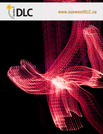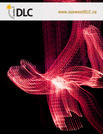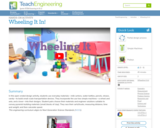
- d-t Graphs- V-T graphs- Examples
- Subject:
- Physics
- Author:
- Distance Learning Centre
- Date Added:
- 04/09/2018

- d-t Graphs- V-T graphs- Examples

- Introduction to Kinematics- Examples

Students are introduced to the concept of projectile motion, of which they are often familiar from life experiences,such as playing sports such as basketball or baseball, even though they may not understand the physics involved. Students use tabletop-sized robots to build projectile throwers and measure motion using sensors. They compute distances and velocities using simple kinematic equations and confirm their results through measurements by hand. To apply the concept, students calculate the necessary speed of an object to reach a certain distance in a hypothetical scenaro: A group of hikers stranded at the bottom of a cliff need food, but rescuers cannot deliver it themselves, so they must devise a way to get the food to the hikers.

Students learn and practice how to find the perimeter of a polygonal shape. Using a ruler, they measure model rooms made of construction paper walls. They learn about other tools, such as a robot, that can help them take measurements. Using a robot built from a LEGO® MINDSTORMS® NXT kit that has been programmed to move along a wall and output the length of that wall, students record measurements and compare the perimeter value found with the robot to the perimeter found using a ruler. In both cases, students sketch maps to the scale of the model room and label the measured lengths. A concluding discussion explores the ways in which using a robot may be advantageous or disadvantageous, and real-world applications.

Students learn how to determine map distances and areas using the map scale. They get a feel for how much an area represents on the map in relation to the size they are suggesting for their underground caverns to shelter the Alabraska population.

This YouTube playlist has video lessons of the various topics in Grade 10 Science in SK.

Objective: Your goal is to create a maze for the Sphero in which you code it to go through a variety of obstacles and requirements!
Learn Distance, rate and time. This could be done with any robot.

This hands-on project is an impactful way to show students how truly immense our solar system is! You get to decide if you want your model to show scale planet sizes or the scale distances between planets. You can combine a planet-size model of one scale with a distance model of another scale. But if you want size and distance to be the same scale, you’ll need to spread your model across at least half a mile!
Specific directions on how to calculate size/distance scales are included.

Students strengthen their communicate skills about measurements by learning the meaning of base units and derived units, including speed one of the most common derived units (distance/time). Working in groups, students measure the time for LEGO MINDSTORMS(TM) NXT robots to move a certain distance. The robots are started and stopped via touch sensors and programmed to display the distance traveled. Using their collected data, students complete a worksheet to calculate the robots' (mean/average) speeds at given motor powers.

Students work as engineers to design and test trebuchets (in this case LEGO® MINDSTORMS® robots) that can launch objects. During the testing stage, they change one variable at a time to study its effect on the outcome of their designs. Specifically, they determine how far objects travel depending on their weights. As students learn about the different components of robot design and the specific function controls, they determine what design features are important for launching objects.

Students learn about and use a right triangle to determine the width of a "pretend" river. Working in teams, they estimate of the width of the river, measure it and compare their results with classmates.

In this activity, students will use vector analysis to understand the concept of dead reckoning. Students will use vectors to plot their course based on a time and speed. They will then correct the positions with vectors representing winds and currents.

This is a lesson about the vertical dimension of the atmosphere and includes four activities. Activity 1 Introduces concepts related to distance, including length and height and units of measurement. Students are asked to make comparisons of distances. In activity 2, students learn about the vertical profile of the atmosphere. They work with a graph and plot the heights of objects and the layers of the atmosphere: troposphere, stratosphere, mesosphere, thermosphere, and exosphere. In activity 3, students learn about other forms of visual displays using satellite imagery. They compare images of the same weather feature, a hurricane, using two different images from MODIS and CALIPSO. One image is looking down on the hurricane from space, the other looks through the hurricane to display a profile of the hurricane. Activity 4 reinforces the concept of the vertical nature of the atmosphere. Students will take a CALIPSO satellite image that shows a profile of the atmosphere and use this information to plot mountains and clouds on their own graph of the atmosphere. The recommended order for the activities is to complete the first two activities on day one, and the second two activities on day two. Each day will require approximately 1 to 1.5 hours.

Students learn about electric motors and rotational sensors. They learn that motors convert electrical energy to mechanical energy and typically include rotational sensors to enable distance measuring. They also learn the basics about gear trains and gear ratios. Students create a basic program using the LEGO MINDSTORMS(TM) NXT interface to control a motor to move a small robot. Then, through a 10-minute mini-activity, they make measurements and observations to test a LEGO rotation sensor's ability to measure distance in rotations. This prepares them for the associated activity during which they calculate how many wheel rotations are needed to travel a distance. A PowerPoint® presentation, worksheet and pre/post quizzes are provided.

In this open-ended design activity, students use everyday materials milk cartons, water bottles, pencils, straws, candy to build small-scale transportation devices. They incorporate the use two simple machines a wheel and axle, and a lever into their designs. Student pairs choose their materials and engineer solutions suitable to convey pyramid-building materials (small blocks of clay). They race their carts/trucks, measuring distance, time and weight; and then calculate speed.

In this lesson, students will learn about kites and gliders and how these models can help in understanding the concept of flight. Students will design and build their own balsa wood models and experiment with different control surfaces. The goal of this lesson is for students to apply their existing knowledge about the four forces affecting flight and apply engineering design to develop a sound glider. They will also communicate the reasoning and results of any design modifications made.